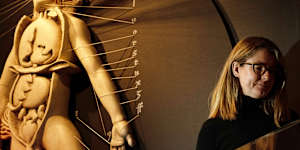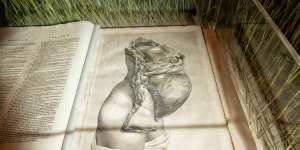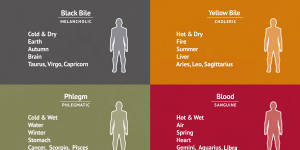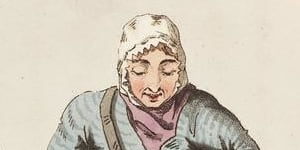It wasn’t until the mid-19th century that most of the life-saving medical advances including anaesthesia,germ theory and vaccines replaced useless and often stomach turning cures for everything from scurvy to mental illness,says Elise Edmonds,the curator of new exhibitionKill or Cure? A Taste of Medicineopening this Saturday.

The State Library of NSW’s senior curator Elise Edmonds in the new exhibition Kill or Cure featuring old and rare medical books. It includes a section on bloodletting and the widespread use of leeches as a cure.Nick Moir
The exhibition showcases 70 of the State Library of NSW’s oldest and rarest medical books dating back to the 1490s.
If Dr Google has you stumped on what ails you,the library has opened 10 treatment rooms that resemble a modern hospital or vaccination centre.

The anatomy of the human gravid uterus exhibited in figures,William Hunter,1815,is on display in the State LIbrary of NSW’s new exhibition Kill or Cure.State Library of NSW
These detail the influence of the stars and the phases of the moon,healing chants and prayers,the knife-wielding barber-surgeon and scientific breakthroughs. Visiting “patients” will experience dubious and often deadly techniques and therapies used to diagnose and treat the sick and diseased.
In what looks like a contemporary waiting room,a video featuring health and science reporter Tegan Taylor of the ABC’sCoronacast warns visitors:“Remember,you’re entering a world where people die young and treatments may kill or cure.”
Until the late 19th century,the power of most cures was only as a placebo,Edmonds said. Patients were prescribed enemas,emetics or bloodletting (sometimes using leeches),along with herbs,exercise and bathing. If someone was sick,their character was often to blame.
In the past leeches were used for bloodletting thought to cure a wide range of illnesses,including epilepsy and bruises. Today they are still used by microsurgeons who reattach body parts such as fingers,toes,thumbs,ears,lips,noses,or even bits of scalp. That’s because leech saliva contains hirudin,an anti-coagulant.
The cure for hysteria,and another malady called “virgin’s disease”,was thought to be marriage and sex. Often women were treated with vaginal pessaries made from all manner of ills,including animal manure and human excrement mixed with beer froth. It wasn’t until after the First World War,when men suffered from shell shock,that doctors realised that hysteria wasn’t only suffered by women,Edmonds said.
Illness was often tied to the four humors,the term used to describe four bodily fluids – blood,yellow bile,black bile and phlegm – Taylor says in the waiting room video.

A graphic from the State Library of NSW ’s new exhibition Kill or Cure explaining old beliefs that tied health to character and the stars.State Library of NSW
“Each humor was linked with two of the four ‘fundamental qualities’. They were hot,cold,wet and dry,and one of four elements:air,fire,earth or water. These in turn were linked to a season,an organ in the body and several astrological signs,” Taylor says.
These humors did not only influence physical and mental health,they also helped shape one’s personality.
Someone like Edmonds,born under the astrological star sign Gemini was thought to be sanguine,“the king of the humors”.
“We are warm and wet,our element is the air and our season is spring,we are sociable,outgoing,carefree and content. This is the ornament of the body,the pride of humors,” she said. Unfortunately for this reporter,also a Gemini,this belief had no basis in science.

Women earned money by collecting leeches used in a range of cures. This illustration comes from a series of 40 engravings,facsimiles of original drawings,1814,by George Walker,printed in London by T Bensley for Longman,Hurst,Rees,Orme and Brown. It is on display as part of the Kill or Cure exhibition at The State Library of NSW.State Library of NSW
Edmonds said staff started researching the exhibition during the early COVID-19 lockdowns,when everyone was hoping for an effective vaccine.
Then,as now,she was struck by the “amazing work” of health professionals and the efficacy of modern medicine.
“There’s so much we take for granted now ... antibiotics,vaccines,anaesthesia,” she said. “Thank God,we have been living in the 21st century.
“We could have lived in a time when we would have been given a concoction of herbs. Or sent to surgery without anaesthesia,with surgeons wearing filthy blood-matted gowns,where handwashing was unheard of,people were bled. That’s what patients had to endure for centuries.”
One of the “treatment rooms” is dedicated to epidemics that until relatively recently in modern history went unchecked. These diseases altered human history – destroying empires and dynasties,dramatically altering the course of wars,reshaping societies and decimating First Nations peoples.
It wasn’t until 1894 when Swiss scientist Alexandre Yersin isolated and identified that the bacteriumYersinia pestis,which caused the plague,the deadliest of epidemics,was carried by fleas. These days,it is easily treated with antibiotics.
For tongues covered in spots and teeth falling out caused by scurvy,don’t try “wort of unfermented beer”. The cause of scurvy was thought to be the “putrification” of body tissue,and the fermentation process inherent in wort of malt delayed or replaced this process.
Despite the inconclusive nature of his own experiments,Captain James Cook reported favourably on the use of wort,and won a prestigious medal for advances in science. Naturalist Joseph Banks escaped scurvy by downing a “rob” of concentrated lemon (mixed with various wines),giving him a high dose of vitamin C,the real cure.
But without modern communication,news of cures for scurvy 300 years earlier,described as the most painful of diseases that left people begging to die,were lost in time. The Lancet reported that 300 years earlier than Cook,explorer Vasco de Gama’s crew recovered from scurvy after being given oranges and lemons by the King of Mombasa
When they went to sea later for three months,The Lancet reported,“It was “a nightmare and,not surprisingly,scurvy killed many sailors. On Jan 7,1499,the ships anchored at Malindi,where the sailors,remembering their previous cure in Mombassa,asked for oranges. Nevertheless,55 men died from a “disease which started in the mouth.”
The Morning Edition newsletter is our guide to the day’s most important and interesting stories,analysis and insights..